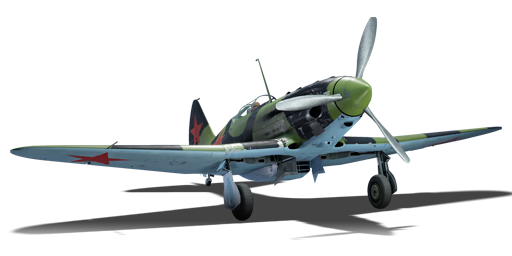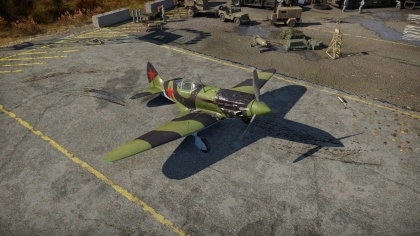MiG-3-15
Contents
| This page is about the aircraft MiG-3-15. For other uses, see MiG-3 (Disambiguation) |
Description
The MiG-3-15 is a Rank I Russian interceptor
with a battle rating of 1.7 (AB/SB) and 2.3 (RB). This aircraft has been in the game since the start of the Open Beta Test prior to Update 1.29.
The MiG-3-15 is the first of the Mikoyan-Gurevich designed aircraft in the USSR tech tree (after the ShKAS-armed I-16s and before the MiG-3-15 (BK) and MiG-3-34), and provides a very interesting Rank II aircraft type to play around with. Unlike its Yak or Lavochkin contemporaries, the MiG-3-15 is more suited to high-altitude combat than low-alt combat, something which is rarely seen in War Thunder realistic battles, and as a result, can lose a fair bit of performance when below around 4,000 m altitude. In arcade battles, it is well suited to hunting higher altitude bombers. In lower ranks, biplanes and more primitive monoplanes will struggle to catch bombers like the He 111 and F.222.2 when they are at high altitude. If they are allowed to reach altitude, bombers can be a serious threat to your base. The MiG-3 can counter these aircraft, quickly reaching their altitude (where it is most effective), and taking them out with its machine guns. Be sure to aim for their cockpit, engines, and wings. Despite the 12.7 mm machine gun, pumping rounds into a bombers fuselage is relatively ineffective.
General info
Flight Performance
| Characteristics | |||||||
|---|---|---|---|---|---|---|---|
| Stock | |||||||
| Max Speed (km/h at 7,800 m) |
Max altitude (meters) |
Turn time (seconds) |
Rate of climb (meters/second) |
Take-off run (meters) | |||
| AB | RB | AB | RB | AB | RB | ||
| 612 | 559 | 12,000 | 25.5 | 26.0 | 12.6 | 12.6 | 300 |
| Upgraded | |||||||
| Max Speed (km/h at 7,800 m) |
Max altitude (meters) | Turn time (seconds) | Rate of climb (meters/second) |
Take-off run (meters) | |||
| AB | RB | AB | RB | AB | RB | ||
| 669 | 640 | 12,000 | 22.5 | 24.0 | 23.7 | 16.0 | 300 |
Details
| Features | ||||
|---|---|---|---|---|
| Combat flap | Take-off flap | Landing flap | Air brakes | Arrestor gear |
| ✓ | ✓ | ✓ | X | X |
| Limits | ||||
|---|---|---|---|---|
| Wing-break speed (km/h) |
Gear limit (km/h) |
Combat flap (km/h) |
Max Static G | |
| + | - | |||
| 620 | 320 | ??? | ~20 | ~9 |
| Optimal velocities | |||
|---|---|---|---|
| Ailerons (km/h) |
Rudder (km/h) |
Elevators (km/h) |
Radiator (km/h) |
| < 350 | < 420 | < 420 | > 260 |
| Compressor (RB/SB) | ||
|---|---|---|
| Setting 1 | ||
| Optimal altitude | 100% Engine power | WEP Engine power |
| 6,100 m | 1,200 hp | 1,446 hp |
Survivability and armour
- 8 mm Steel plate behind the pilot.
- 8.5 mm Steel plate under the pilot.
- No armour glazing
- Critical components located at front of aircraft (fuel, pilot, engine, controls)
- More fuel tanks located in wings near fuselage
Armaments
Offensive armament
The MiG-3-15 is armed with:
- 1 x 12.7 mm Berezin UB machine gun, nose-mounted (300 rpg)
- 2 x 7.62 mm ShKAS machine guns, nose-mounted (750 rpg = 1,500 total)
Usage in the battles
The MiG-3 has a few issues that can hinder its success on the battlefront. Its power plant, although powerful for its time, performs best above 4000 m (approx. 12,000 ft) altitude, and as a result the early MiG's speed and climb rate at lower altitudes may be disappointing at first, particularly when stock. Its armament, one 12.7 mm Berezin UB machine gun and two 7.62 mm ShKAS machine guns, is generally inferior to its Allied and German opposition (its contemporaries on the Eastern Front, the Emil and Friedrich 109s, have 20 mm cannon armament on hand). Maneuverability can be a problem, especially at lower altitudes, as the plane bleeds speed in turns and can lock up at high speeds during dives. Despite these flaws, the MiG-3 in all its variants can be seen as a good stepping stone towards learning how to utilize the tricky-to-fly I-185s, especially in practicing Boom & Zoom attacks as well as energy fighting.
Specific enemies worth noting
- Bf 109 E-1- The Bf 109 shares your BR in AB, so you will be facing them a lot. They have a higher top speed, perform well at high altitude (above 4000 m like the MiG-3) and have great energy retention. You do have some firepower advantage but a battle with a Bf 109 E-1 often becomes a battle of energy retention; the pilot with higher energy often wins. Try to get a height advantage when going against one and take it by surprise.
- Spitfire Mk Ia - The Spitfire is one of the most maneuverable monoplanes in the game, and has great anti fighter capabilities with its 8 x 7.7 mm machine guns. DO NOT engage a Spitfire in a turn fight. You will lose your speed and be easily out turned. The Spitfire is also quite fast and accelerates well, so don't be surprised if after a failed boom and zoom attempt you have a Spitfire gaining on your tail. Luckily, the Spitfire performs poorly at high altitude, meaning that if you can lure one up to 3000 m, you can then sap it of its energy and hopefully kill it. The Spitfire is a poor diver too, so if one tries to escape, you can quickly out dive it. This also makes for a nice defensive option.
- A6M2-N - Like the Spitfire, except slower, more maneuverable and with a great big float to shoot at (don't, it will gain even more manoeuverability). Same rules apply. Don't turn fight, just boom and zoom. The incendiary ammo from your 12.7 mm will set these on fire easily.
- P-36 (all variants) - The P-36 is very well armed (4 x 7.62 mm Browning machine guns and 2 x 12.7 mm M2 Browning machine guns), meaning that it has an edge in firepower over the MiG-3. It also has an edge in manoeuverability, whilst also being quite fast. This makes it a challenging opponent. Your performance is superior to the P-36 over 4000 m, so try to lure it up to higher altitudes. You also have a much better climb rate than the P-36, so get an altitude advantage and then dive. Boom and Zoom works best here.
Manual Engine Control
| MEC elements | ||||||
|---|---|---|---|---|---|---|
| Mixer | Pitch | Radiator | Supercharger | Turbocharger | ||
| Oil | Water | Type | ||||
| Controllable | Not controllable | Not controllable | Not controllable | Separate | Not ontrollable | Not controllable |
Modules
| Tier | Flight performance | Survivability | Weaponry | |
|---|---|---|---|---|
| I | Fuselage Repair | Radiator | Offensive 7 mm | |
| II | Compressor | Airframe | New 7 mm MGs | |
| III | Wings Repair | Engine | Offensive 12 mm | |
| IV | Engine Injection | Cover | New 12 mm MGs | |
Pros and cons
Pros:
- Gets air spawn in RB.
- Decent climber - one of the few Soviet prop-fighters that can use WEP well.
- Good for high-altitude fighting.
- Efficient at gliding - this is useful in case of oil leak or engine damage.
- Nose mounted armament makes for very accurate shooting.
- 12.7 mm and 2 x 7.62 mm ShKAS is more than adequate to deal with aircraft the MiG-3 faces.
Cons:
- Not the most manoeuverable fighter in Rank II.
- Performance is a bit disappointing below 4000 m.
- Controls can lockup at high speeds.
- Overheats easily with WEP.
History
"The Mikoyan-Gurevich MiG-3 (Russian: Микоян и Гуревич МиГ-3) was a Soviet fighter and interceptor aircraft used during World War II. It was a development of the MiG-1 by the OKO (opytno-konstruktorskij otdel — Experimental Design Department) of Zavod (Factory) No. 1 to remedy problems found during the MiG-1's development and operations. It replaced the MiG-1 on the production line at Factory No. 1 on 20 December 1940 and was built in large numbers during 1941 before Factory No. 1 was converted to build the Ilyushin Il-2.
On 22 June 1941, at the beginning of Operation Barbarossa, some 981 were in service with the Soviet Air Forces (VVS), the Soviet Air Defence Forces (PVO) and Soviet Naval Aviation. The MiG-3 was difficult to fly in peacetime and much more so in combat. It had been designed for high-altitude combat but combat over the Eastern Front was generally at lower altitudes, where it was inferior to the German Messerschmitt Bf 109 as well as most of its Soviet contemporaries. It was also pressed into service as a fighter-bomber during the autumn of 1941 but it was equally unsuited for this. The losses suffered in combat were very high, in percentage the highest among all the VVS fighters, with 1,432 shot down planes. Over time, the survivors were concentrated in the PVO, where its disadvantages mattered less, the last being withdrawn from service before the end of the war."[1]
(https://en.wikipedia.org/wiki/Mikoyan-Gurevich_MiG-3)
Media
An excellent addition to the article will be video guides, as well as screenshots from the game and photos.
Read also
Links to the articles on the War Thunder Wiki that you think will be useful for the reader, for example,
- reference to the series of the aircraft;
- links to approximate analogues of other nations and research trees.
Sources
Paste links to sources and external resources, such as:
- topic on the official game forum;
- page on aircraft encyclopedia;
- other literature.
| USSR fighters | |
|---|---|
| I-15 | I-15 WR · I-15 M-22 · I-15 M-25 · I-15bis · Krasnolutsky's I-15bis |
| I-153 M-62 · Zhukovsky's I-153-M62 · I-153P | |
| I-16 | I-16 type 5 · I-16 type 10 · I-16 type 18 · I-16 type 24 · I-16 type 27 · I-16 type 28 · I-180S |
| I-29 | I-29 |
| I-185 | I-185 (M-71) · I-185 (M-82) |
| I-225 | I-225 |
| ITP | ITP (M-1) |
| MiG-3 | MiG-3-15 · MiG-3-15 (BK) · MiG-3-34 |
| LaGG | I-301 · LaGG-3-4 · LaGG-3-8 · LaGG-3-11 · LaGG-3-23 · LaGG-3-34 · LaGG-3-35 · LaGG-3-66 |
| La | La-5 · La-5F · La-5FN · La-7 · Dolgushin's La-7 · La-7B-20 · La-9 · La-11 |
| Yak-1/7 | Yak-1 · Yak-1B · Yak-7B |
| Yak-3 | Yak-3 · Yak-3P · Yak-3T · Yak-3U · Yak-3 (VK-107) |
| Yak-9 | Yak-9 · Yak-9B · Golovachev's Yak-9M · Yak-9T · Yak-9K · Yak-9U · Yak-9UT · Yak-9P |
| Other countries | ▂P-40E-1 · ▂P-47D-27 · ▂Hurricane Mk IIB · ▂Fw 190 D-9 · ▂Spitfire Mk IXc |
| P-39 | ▂P-39K-1 · ▂Pokryshkin's P-39N-0 · ▂P-39Q-15 |
| P-63 | ▂P-63A-5 · ▂P-63A-10 · ▂P-63C-5 |





